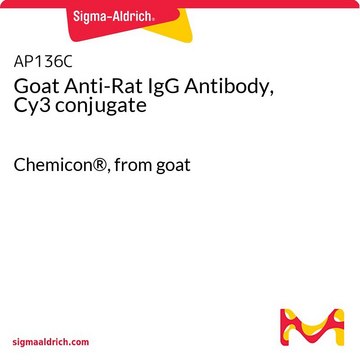AP183C
Goat Anti-Rat IgG Antibody, Cy3 conjugate, Species Adsorbed
1.4 mg/mL, Chemicon®
Sign Into View Organizational & Contract Pricing
All Photos(1)
About This Item
UNSPSC Code:
12352203
eCl@ss:
32160702
NACRES:
NA.46
Recommended Products
biological source
goat
Quality Level
conjugate
CY3 conjugate
antibody form
F(ab′)2 fragment of affinity isolated antibody
antibody product type
secondary antibodies
clone
polyclonal
species reactivity
rat
manufacturer/tradename
Chemicon®
concentration
1.4 mg/mL
technique(s)
immunofluorescence: suitable
shipped in
wet ice
target post-translational modification
unmodified
Related Categories
Specificity
Reacts with heavy chain of Rat IgG, as well as the light chains from most rat immunoglobulin classes.
Monospecific on IEP against whole Mouse Serum.
FLOUROPHORE/PROTEIN RATIO:
A552/A280 = 2.5
Monospecific on IEP against whole Mouse Serum.
FLOUROPHORE/PROTEIN RATIO:
A552/A280 = 2.5
Immunogen
Highly purified Rat IgG isolated from pooled normal Mouse Serum.
Application
1:100 - 1:800 for most applications.
Goat anti-Rat IgG Antibody, Cy3 conjugate, Species Adsorbed is an antibody against Rat IgG for use in IF.
Research Category
Secondary & Control Antibodies
Secondary & Control Antibodies
Research Sub Category
Secondary Antibodies Adsorbed for Dual Labeling
Secondary Antibodies Adsorbed for Dual Labeling
Storage and Stability
Store at +2-8°C. Do not freeze. After opening, restore to 0.4mL with distilled water. As an undiluted liquid the product is stable at 2-8°C for several weeks. For extended storage after reconstitution, we suggest the addition of an equal volume of glycerol to make a final glycerol concentration of 50% followed by storage at -20°C, with or without aliquoting. Exp. Date: 1 year from reconstitution.
Legal Information
CHEMICON is a registered trademark of Merck KGaA, Darmstadt, Germany
Disclaimer
Unless otherwise stated in our catalog or other company documentation accompanying the product(s), our products are intended for research use only and are not to be used for any other purpose, which includes but is not limited to, unauthorized commercial uses, in vitro diagnostic uses, ex vivo or in vivo therapeutic uses or any type of consumption or application to humans or animals.
Not finding the right product?
Try our Product Selector Tool.
Hazard Statements
Precautionary Statements
Hazard Classifications
Aquatic Chronic 3
Storage Class Code
11 - Combustible Solids
WGK
WGK 3
Certificates of Analysis (COA)
Search for Certificates of Analysis (COA) by entering the products Lot/Batch Number. Lot and Batch Numbers can be found on a product’s label following the words ‘Lot’ or ‘Batch’.
Already Own This Product?
Find documentation for the products that you have recently purchased in the Document Library.
The role of T-cadherin in axonal pathway formation in neocortical circuits.
Hayano, Y; Zhao, H; Kobayashi, H; Takeuchi, K; Norioka, S; Yamamoto, N
Development null
Masato Uemura et al.
Scientific reports, 12(1), 11933-11933 (2022-07-14)
Protocadherin 9 (Pcdh9) is a member of the cadherin superfamily and is uniquely expressed in the vestibular and limbic systems; however, its physiological role remains unclear. Here, we studied the expression of Pcdh9 in the limbic system and phenotypes of
Shinichi Nakagawa et al.
The Journal of cell biology, 193(1), 31-39 (2011-03-30)
Nuclei of higher organisms are well structured and have multiple, distinct nuclear compartments or nuclear bodies. Paraspeckles are recently identified mammal-specific nuclear bodies ubiquitously found in most cells cultured in vitro. To investigate the physiological role of paraspeckles, we examined
Paul G Anastasiades et al.
Nature communications, 7, 10584-10584 (2016-02-05)
GABAergic interneurons play key roles in cortical circuits, yet little is known about their early connectivity. Here we use glutamate uncaging and a novel optogenetic strategy to track changes in the afferent and efferent synaptic connections of developing neocortical interneuron
Our team of scientists has experience in all areas of research including Life Science, Material Science, Chemical Synthesis, Chromatography, Analytical and many others.
Contact Technical Service








